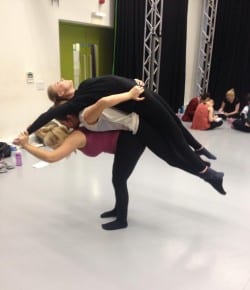Starting the workshop with a warm up consisting on folding, pushing and pulling.We then experimented with spiraling, keeping in contact with our partners whilst spiraling around one another. This i found helpful and useful as it is a tool which allows you to stay in contact with your partner at all times. The weight exchange and speed of the movement allowed us to listen to one another whilst being focused and in touch with ourselves.
We then went on to focus on our scores which we looked at last week. We developed them in order to create a more effective piece. The set rules in which we followed were
- 2 people out at all times
- when a duo starts travel the opposite way in which you start
- If you make a trio initiate the change of direction
- every time you come out of the space set yourself a new rule
- End the score using small dance and in a sustained position
We performed the score and were given feedback. In order to make our score successful we were to make our choices more obvious by setting clear direction. The idea of two people being out at all time worked effectively however the audience thought having more people out would allow certain duo’s and trio’s to attract the audiences attention. From this i found myself thinking about the things in which i would like to improve on or try more. When we performed the score again i found that the set direction worked more fluently. I set myself three tasks throughout the score. My first one was to never touch the floor, this made me focus on the use of lifts in order for the duet to work. This method i found successful as i took risks which i usually wouldn’t. Secondly,i decided to increase the pace of my movements, i linked onto a duet which i found was rather slow paced and used the idea of initiating set direction to also initiate a quicker pace. This took time, as it required adjustment for the other dancers, however the transition worked effectively. Finally, the other method which i was eager to experiment with was the challenge to not use arms to create lifts. This was a difficult task as i had to find several other structures within my body which my partner could use as a support during a lift. From the second score, we found the rule of having more people out gave time for effective, impressive duos to take place. We were told to move down stage as the space wasn’t being utilized enough, this was something to take on board for the open jam.
Open Studio
Commencing before the open score was a jam which lasted several minutes. Within this we became in touch with our kinespehere and skinesphere as well as those around us. Using pushing and pulling motions i found my self relaxed and focused on the score ahead. Rolling among the ground and others around me i came into touch with others and started to perform contact improvisation. Starting out of the space i found myself coming into a duet to start the score. Here i gave myself a rule to never touch the floor providing mid level structures for my partner as well as participating lifts, and resisting against the urge to use the ground. Throughout the piece i focused on using the front of the space as well as applying set direction, i wanted the audience to feel involved in the piece, and not like outsiders. This i found worked effectively. Coming out of the space i found it exciting to watch our score developing. The use of direction worked effectively and was easing for the eye as it allowed me to focus on the movement specifically. Also, i found within the score the set rules which people personally applied, changing slow duo’s and attempting to speed them up. Also, i witnessed people resisting against the ground in order to experiment with movements on a medium and high level, which worked effectively as they incorporated lifts within the space.
